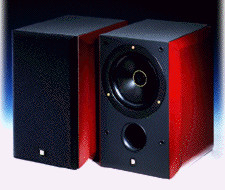| Columns Retired Columns & Blogs |
KEF RDM Two loudspeaker
Stereophile is, in one sense, like a family—us younguns have to make do sometimes because the house is straining at the seams. When I first arrived in Santa Fe, for instance, I was told not to come to the office for a few days—the good news, John Atkinson informed me, was that I had a desk; the bad news was that nobody had a clue where to put it. The dilemma was solved in Solomon-like fashion by shoehorning my desk into the "listening room," which was already serving double-duty as audition space and speaker-measurement lab. If manufacturers visited, we'd sweep up all the acoustic damping from the floor and stash it in JA's office; and if JA needed to take measurements, I would be asked to work at home. It was a manifestly fair solution: inconvenient for everyone involved.
Footnote 1: I tend to use Ryko's The Atmosphere Collection of CDs as socially acceptable pink noise. I find the sounds of rainfall, waterfalls, and babbling brooks soothing, even for days on end, whereas even two minutes of pink noise really gets on my nerves.
 But sometimes it has its moments. Not long ago, I was sitting at my desk, covering my ears every time John sent a toneburst through a loudspeaker, when he turned to me and pointed at the gray-clad loudspeaker perched on the testing turntable. "These KEF RDM Twos really measure a treat. Michael Fremer loved 'em in his review in the January 1998 issue of Stereophile Guide to Home Theater, as did Sam Tellig in his October '97 "Sam's Space" column—maybe someone should take an in-depth look at them for Stereophile."
But sometimes it has its moments. Not long ago, I was sitting at my desk, covering my ears every time John sent a toneburst through a loudspeaker, when he turned to me and pointed at the gray-clad loudspeaker perched on the testing turntable. "These KEF RDM Twos really measure a treat. Michael Fremer loved 'em in his review in the January 1998 issue of Stereophile Guide to Home Theater, as did Sam Tellig in his October '97 "Sam's Space" column—maybe someone should take an in-depth look at them for Stereophile."
"Umm," I responded, engrossed in my e-mail.
"I said, maybe somebody should look at them for Stereophile."
"Oh!" I caught on. "I'll take 'em home and give 'em a listen."
I'm glad I did—they proved to be an exciting, fascinating, frustrating speaker to play with.
Cries of discovery
The RDM Twos aren't just a couple of drivers thrown into a wooden box; everything about them bespeaks careful attention to detail. They're hefty for their size, weighing in at nearly 20 lbs each. The cabinets are made from Nextel-painted MDF and have handsomely finished, 1"-thick, beveled side-panels bolted on. On the review samples, these "cheeks" were finished in glossy but understated gray; red lacquer and cherry veneer panels are also available.
The cabinet seemed solid and free from ringing or rattling. A crossover/double-binding-post assembly bolts into the rear panel, while the baffle is dominated by the 5" polypropylene-cone woofer with the 1" tweeter mounted in its throat. (The tweeter stays in place while the woofer cone vibrates.) This dual drive-unit is located above a flared, 3" port tube. KEF calls its concentric driver design "Uni-Q"; its purpose is to create an effective point source, avoiding the crossover phase anomalies and the discontinuities in dispersion that can occur when drivers are located at a distance from one another. The speaker's horizontal dispersion will be uniform; ditto for vertical dispersion.
From a whisper to a scream
I understood immediately why MF and ST had so enjoyed the RDM Two—it impressed me from the get-go with its warm and dynamic presentation of music. It is also wonderfully articulate. This is a speaker that almost seems to sit up and beg you to play your favorite music.
I began my session with Jack DeJohnette's Oneness (ECM 1637). The KEF did a marvelous job of portraying the crisp dynamics of DeJohnette's intensely rhythmic drumming—as well as carefully articulating Don Alias' imaginative percussion. The RDM Twos were also meticulous in differentiating between the two players, both tonally and spatially, which is a pretty fine piece of footwork.
Yet I was a bit troubled by the sound of Michael Cain's piano. On other, admittedly more and much more expensive minimonitors such as the ProAc Response One SC ($2100/pair, reviewed elsewhere in this issue) and JA's reference, the B&W John Bowers Silver Signature ($7500/pair), the piano sounded as a relatively close-miked piano ought: big, clear, and dynamic. But the KEF imparted a nasal quality to the keyboard—it sounded less like a grand and much more like a fortepiano, even down to a muted quality in the overtone structures.
I wondered if the speakers needed more burn-in, so I placed Waterfall: A Week in Hawaii (Rykodisc RCD 30068) in the Meridian 508-24, set it to Repeat, and went on about my business (footnote 1). Again I found the sound somewhat muted on top—there was more water roar and less "tinkle" of individual water droplets. To anthropomorphize, the waterfall sounded more like a baritone than the tenor I was used to hearing. Still, as a speaker designer once said to me, "Who ever listens to pink noise?
Footnote 1: I tend to use Ryko's The Atmosphere Collection of CDs as socially acceptable pink noise. I find the sounds of rainfall, waterfalls, and babbling brooks soothing, even for days on end, whereas even two minutes of pink noise really gets on my nerves.
- Log in or register to post comments




































